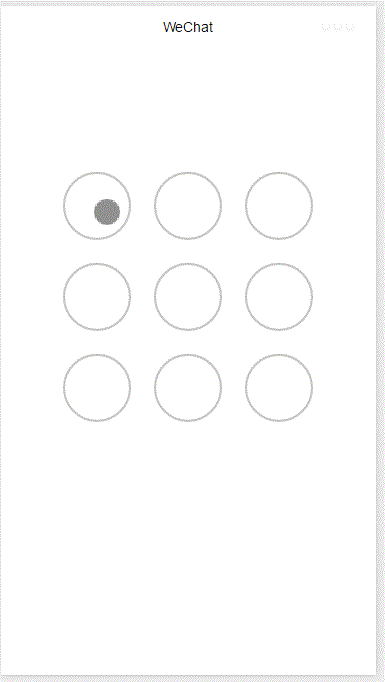
Le déverrouillage gestuel est une méthode de déverrouillage courante sur l'application, et elle est beaucoup plus pratique à utiliser que la saisie d'un mot de passe. Ce qui suit montre comment déverrouiller le téléphone en fonction de l'applet WeChat. L'effet final est le suivant :

Déverrouillage gestuel
La fonction entière est basée sur le canevas. Ajoutez d'abord le composant canevas et. définissez le style.
<!--index.wxml-->
<view class="container">
<canvas canvas-id="id-gesture-lock" class="gesture-lock" bindtouchstart="onTouchStart"
bindtouchmove="onTouchMove" bindtouchend="onTouchEnd"></canvas>
</view>
.gesture-lock {
margin: 100rpx auto;
width: 300px;
height: 300px;
background-color: #ffffff;
}Le code d'implémentation du déverrouillage par gestes se trouve dans geste_lock.js (voir la fin pour l'adresse complète du code source).
Initialisation
constructor(canvasid, context, cb, opt){
this.touchPoints = [];
this.checkPoints = [];
this.canvasid = canvasid;
this.ctx = context;
this.width = opt && opt.width || 300; //画布长度
this.height = opt && opt.height || 300; //画布宽度
this.cycleNum = opt && opt.cycleNum || 3;
this.radius = 0; //触摸点半径
this.isParamOk = false;
this.marge = this.margeCircle = 25; //触摸点及触摸点和画布边界间隔
this.initColor = opt && opt.initColor || '#C5C5C3';
this.checkColor = opt && opt.checkColor || '#5AA9EC';
this.errorColor = opt && opt.errorColor || '#e19984';
this.touchState = "unTouch";
this.checkParam();
this.lastCheckPoint = null;
if (this.isParamOk) {
// 计算触摸点的半径长度
this.radius = (this.width - this.marge * 2 - (this.margeCircle * (this.cycleNum - 1))) / (this.cycleNum * 2)
this.radius = Math.floor(this.radius);
// 计算每个触摸点的圆心位置
this.calCircleParams();
}
this.onEnd = cb; //滑动手势结束时的回调函数
}Définissez principalement certains paramètres, tels que la longueur et la largeur du canevas, le contexte du canevas et le nombre de verrous gestuels ( 3 fois 3, 4 fois 4 ), la couleur du verrouillage gestuel, la fonction de rappel à la fin du glissement gestuel, etc. Et calculez le rayon du verrouillage gestuel.
Calculez la position centrale de chaque verrouillage gestuel
calCircleParams() {
let n = this.cycleNum;
let count = 0;
for (let i = 0; i < n; i++) {
for (let j = 0; j < n; j++){
count++;
let touchPoint = {
x: this.marge + i * (this.radius * 2 + this.margeCircle) + this.radius,
y: this.marge + j * (this.radius * 2 + this.margeCircle) + this.radius,
index: count,
check: "uncheck",
}
this.touchPoints.push(touchPoint)
}
}
}Dessinez le verrouillage gestuel
for (let i = 0; i < this.touchPoints.length; i++){
this.drawCircle(this.touchPoints[i].x, this.touchPoints[i].y, this.radius, this.initColor)
}
this.ctx.draw(true);Le suivant L'étape consiste à reconnaître le comportement de glissement de l'utilisateur, à déterminer les cercles que l'utilisateur a traversés, puis à identifier les gestes de l'utilisateur.
Détecter les déclencheurs dans les événements touchstart et touchmove et mettre à jour le canevas
<p style="margin-bottom: 7px; margin-top: 14px;"> onTouchStart(e) {<br/> // 不识别多点触控<br/> if (e.touches.length > 1){<br/> this.touchState = "unTouch";<br/> return;<br/> }<br/> this.touchState = "startTouch";<br/> this.checkTouch(e);<br/> let point = {x:e.touches[0].x, y:e.touches[0].y};<br/> this.drawCanvas(this.checkColor, point);<br/> }<br/><br/> onTouchMove(e) {<br/> if (e.touchState === "unTouch") {<br/> return;<br/> }<br/> if (e.touches.length > 1){<br/> this.touchState = "unTouch";<br/> return;<br/> }<br/> this.checkTouch(e);<br/> let point = {x:e.touches[0].x, y:e.touches[0].y};<br/> this.drawCanvas(this.checkColor, point);<br/> }<br/></p>Détecter si l'utilisateur a traversé un cercle
checkTouch(e) {
for (let i = 0; i < this.touchPoints.length; i++){
let point = this.touchPoints[i];
if (isPointInCycle(e.touches[0].x, e.touches[0].y, point.x, point.y, this.radius)) {
if (point.check === 'uncheck') {
this.checkPoints.push(point);
this.lastCheckPoint = point;
}
point.check = "check"
return;
}
}
}Mettre à jour le canevas
drawCanvas(color, point) {
//每次更新之前先清空画布
this.ctx.clearRect(0, 0, this.width, this.height);
//使用不同颜色和形式绘制已触发和未触发的锁
for (let i = 0; i < this.touchPoints.length; i++){
let point = this.touchPoints[i];
if (point.check === "check") {
this.drawCircle(point.x, point.y, this.radius, color);
this.drawCircleCentre(point.x, point.y, color);
}
else {
this.drawCircle(this.touchPoints[i].x, this.touchPoints[i].y, this.radius, this.initColor)
}
}
//绘制已识别锁之间的线段
if (this.checkPoints.length > 1) {
let lastPoint = this.checkPoints[0];
for (let i = 1; i < this.checkPoints.length; i++) {
this.drawLine(lastPoint, this.checkPoints[i], color);
lastPoint = this.checkPoints[i];
}
}
//绘制最后一个识别锁和当前触摸点之间的线段
if (this.lastCheckPoint && point) {
this.drawLine(this.lastCheckPoint, point, color);
}
this.ctx.draw(true);
}Appeler la fonction de rappel lorsque le balayage de l'utilisateur se termine et transmettre le geste reconnu
onTouchEnd(e) {
typeof this.onEnd === 'function' && this.onEnd(this.checkPoints, false);
}
onTouchCancel(e) {
typeof this.onEnd === 'function' && this.onEnd(this.checkPoints, true);
}Réinitialiser et afficher l'erreur de geste
gestureError() {
this.drawCanvas(this.errorColor)
}
reset() {
for (let i = 0; i < this.touchPoints.length; i++) {
this.touchPoints[i].check = 'uncheck';
}
this.checkPoints = [];
this.lastCheckPoint = null;
this.drawCanvas(this.initColor);
}Comment appeler
pour créer un objet de verrouillage dans la méthode onload et dans l'événement tactile de l'utilisateur Appel la méthode correspondante
onLoad: function () {
var s = this;
this.lock = new Lock("id-gesture-lock", wx.createCanvasContext("id-gesture-lock"), function(checkPoints, isCancel) {
console.log('over');
s.lock.gestureError();
setTimeout(function() {
s.lock.reset();
}, 1000);
}, {width:300, height:300})
this.lock.drawGestureLock();
console.log('onLoad')
var that = this
//调用应用实例的方法获取全局数据
app.getUserInfo(function(userInfo){
//更新数据
that.setData({
userInfo:userInfo
})
that.update()
})
},
onTouchStart: function (e) {
this.lock.onTouchStart(e);
},
onTouchMove: function (e) {
this.lock.onTouchMove(e);
},
onTouchEnd: function (e) {
this.lock.onTouchEnd(e);
}Ce qui précède est le contenu détaillé de. pour plus d'informations, suivez d'autres articles connexes sur le site Web de PHP en chinois!
 Comment implémenter la fonction de chat en ligne de Vue
Comment implémenter la fonction de chat en ligne de Vue
 Top 10 des bureaux de change
Top 10 des bureaux de change
 menu contextuel
menu contextuel
 Comment ajuster la taille du texte dans les messages texte
Comment ajuster la taille du texte dans les messages texte
 Avantages du téléchargement du site officiel de l'application Yiou Exchange
Avantages du téléchargement du site officiel de l'application Yiou Exchange
 vue de clé sans fil
vue de clé sans fil
 Comment utiliser le stockage local
Comment utiliser le stockage local
 qu'est-ce que la fonction
qu'est-ce que la fonction